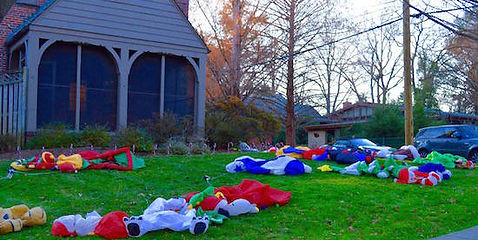top of page

Airformz Mobile Application: Revolutionizing Holiday Decor Control
What is Airformz?
Airformz by Aqua Leisure are holiday air-blown lawn inflatables, designed to to show off your holiday spirit to all of your neighbors.
My challenge was to design an IOS application that would allow users to control their holiday air-blown lawn inflatables from their phones.
I conceptualized and visualized the creation of the Airformz Mobile application.
CLIENT
Aqua Leisure Inc
MY ROLE
Information Architect
Prototyping
UI Design
TIMELINE
2017
3 week sprint
2 week testing review
TOOLS
Adobe Creative Suite
Marvel
Client goals
My client wanted to bring new technology to a product that already exists on the market. They were interested in the potential of lawn inflatable control from the consumers phone becoming an expected value within the market.
Consumer Problem
Despite the popularity of air-blown lawn inflatables, consumers have grappled with the aftermath—messy front yards and high electricity costs. Running these inflatables 24/7 is heavy on your wallet and the alternative results in deflation, turning festive displays into unimpressive heaps of fabric. Users needed a solution to hide deflated decorations and a convenient way to manage light, timing and sound settings.



An Innovative Solution
Our product development team addressed this challenge by designing tension bands to systematically gather the fabric, allowing users to consolidate their Airformz into a themed package. The robust fan ensured inflation even with tension bands, and when turned off, the bands discreetly pulled the fabric to the center, hiding the uninflated fabric neatly within its packaging.




Wire-frame Development
As the lead designer, I crafted the interface and interactions for the Airformz Mobile application. The design aimed for simplicity to accommodate users of all ages, from children to grandparents. Large buttons and a comprehensive bottom toolbar simplified navigation, making every menu easily accessible. The final wireframe and information architecture formed the blueprint for the application.

Usability Testing and Iterative Improvements
Following the wireframe development, we conducted usability testing by transforming the screens into a prototype using Marvel. Three test subjects, aligning with our primary persona, engaged in unmoderated usability testing. Our objective was to uncover insights into user interaction and identify areas for improvement. Certain users reported challenges in navigating the application, highlighting the presence of multiple pathways. Issues also arose during the submission of settings, with users assuming automatic saving of changes. Furthermore, comprehension difficulties were noted regarding the meaning of specific icons within the app.
We logged user feedback and synthesized it through an affinity mapping. The key takeaways informed us about the need to clarify the submission process, simplify the navigation system and enhance iconography comprehension. Our next steps include addressing these issues and conducting further user research to refine the user experience.
Next Steps
Reflecting on this early UX project, I take pride in the innovative product created for Aqua Leisure, marking my initiation into the world of UX design. If given the chance to revisit the process, I'd enhance my approach and emphasize on accessibility. Further research into consumer demographics and competitor products would inform a more nuanced design, minimizing overlap with existing catalogs. Additionally, direct collaboration with developers throughout the process would strengthen the synergy between design and implementation. Although these steps are retrospective, they underscore the iterative nature of UX design and the continual pursuit of refinement.
bottom of page

